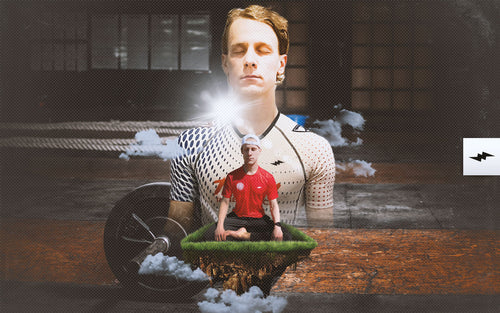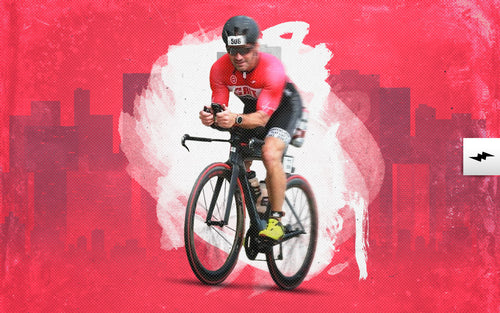The Early Vertical Forearm Continued: Drills

In the last post, we went over the swim technique with a focus on the early vertical forearm (EVF). Today we will be going over some ways to improve the EVF and work on swim specific strength.
In-Water Drills
There are bazillion swim drills out there. My recommendation is to choose a few drills to focus on that address a part of your stroke that needs improvement. Work on them consistently – I recommend doing 25-yard repeats of the same few drills during the warmup for every swim workout. The improvement here is not going to come with throwing in a few random drills every now and then. Here are some drills to improve your EVF catch and set you up for a powerful, efficient stroke.
First drill:

Swim regular freestyle with your hand in a fist. This will force you to use the entire forearm to catch and pull the water immediately.
Paddle wrist block drill:

In this drill, you will use paddles a little differently. Instead of wearing the paddle as you normally would, grab the top of the paddle so that the paddle extends across the wrist joint.
Similar to the first drill, except the paddle prevents the wrist from flexing and gives you more surface area along the forearm to promote an early bend at the elbow and pull through using the entire forearm and hand.
Sculling:

There are several different sculling techniques, but the one shown above will encourage a better EVF catch and feel of the water. Sculling is a drill used by swimmers to develop a “feel” for the water, and improve the pressure of the hand and arms on the water – the goal is to “hold” the water rather than slice through it with a rigid hand, or let it slip away with a soft hand. It’s all about finding that sweet spot and the right amount of tension in the arms and hands.
For this particular scull drill, elbows should maintain a “high” bent position. The forearms and hands will move in and out (roughly in the range pictured above). The palms should be facing the direction the hand is moving at all times and will travel a small figure-8 pattern through the water. This will encourage using the hands and forearms as one unit while maintaining a high elbow to improve the first part of your catch and stroke. This can be done in a horizontal position, kicking and moving forward in the water, or standing in place to work on improving your feel or the water.
Swim Bands

Swim bands are a great tool to improve the EVF muscle memory, as well as increasing swim specific strength. They can be used in a pinch when you don’t have access to a pool, or be great dryland warm-up before a race. You should use bands that have medium resistance so that it is challenging without being so heavy that it alters your stroke or causes compensation.
With tubing/band work, you are only concerned with the pull portion of the stroke, when the arm would be in the water. Do not perform the recovery portion of your stroke, or the part when the arm would be out of the water with bands – simply reverse the motion of the pull to bring the arm back to the starting point.

Focus on bending at the elbow right away so you can use the entire hand and forearm to pull backward. Try to keep the wrist relatively straight, but it may bend a bit as shown above to prevent the band from slipping off.

Continue the pull through, engaging the lats as you would when you push on the deck to get out of the pool.

Push all the way through to a strong finish. You will feel the triceps really work here, and for another drill to isolate them you can work on the finishing phase only. Return to the starting position by reversing the pull-through motion. Remember not to do the typical recovery phase as you would in the water.

Avoid this pattern – allowing the elbow to drop means you are pushing the water down – not backward to propel yourself forward. Technique and form should always be the priority with band work. It is a great strength specific exercise for swimming, and the strength will come, but we want to make sure we are strengthening in the movement pattern you want to swim with – the EVF and not allowing the elbow to drop.
Implementing bands:
Begin with 3 x 10 pulls with each arm, keeping the focus on technique:
- Maintain a straight wrist in line with the forearm.
- Elbow bend will begin the catch as your fingertips move downward and upper arm stays raised.
- Once the arm is “underneath” the elbow/head, the arm continues the pull through and ends with a strong finish and extension of the elbow.
After a couple of weeks, you can progress to 3 x 15 with each arm.
- You can alternate arms, do one arm at a time, or do with two arms simultaneously.
After 1-2 months, if you feel confident in your ability to maintain your form you can transition to training by time instead of repetitions. Gradually progress the time from 30” to build strength and maintain form.
I recommend doing this on the pool deck before swimming to prime your technique before completing swim workouts. 3x/week is a good place to start.



In the last post, we went over the swim technique with a focus on the early vertical forearm (EVF). Today we will be going over some ways to improve the EVF and work on swim specific strength.
In-Water Drills
There are bazillion swim drills out there. My recommendation is to choose a few drills to focus on that address a part of your stroke that needs improvement. Work on them consistently – I recommend doing 25-yard repeats of the same few drills during the warmup for every swim workout. The improvement here is not going to come with throwing in a few random drills every now and then. Here are some drills to improve your EVF catch and set you up for a powerful, efficient stroke.
First drill:

Swim regular freestyle with your hand in a fist. This will force you to use the entire forearm to catch and pull the water immediately.
Paddle wrist block drill:

In this drill, you will use paddles a little differently. Instead of wearing the paddle as you normally would, grab the top of the paddle so that the paddle extends across the wrist joint.
Similar to the first drill, except the paddle prevents the wrist from flexing and gives you more surface area along the forearm to promote an early bend at the elbow and pull through using the entire forearm and hand.
Sculling:

There are several different sculling techniques, but the one shown above will encourage a better EVF catch and feel of the water. Sculling is a drill used by swimmers to develop a “feel” for the water, and improve the pressure of the hand and arms on the water – the goal is to “hold” the water rather than slice through it with a rigid hand, or let it slip away with a soft hand. It’s all about finding that sweet spot and the right amount of tension in the arms and hands.
For this particular scull drill, elbows should maintain a “high” bent position. The forearms and hands will move in and out (roughly in the range pictured above). The palms should be facing the direction the hand is moving at all times and will travel a small figure-8 pattern through the water. This will encourage using the hands and forearms as one unit while maintaining a high elbow to improve the first part of your catch and stroke. This can be done in a horizontal position, kicking and moving forward in the water, or standing in place to work on improving your feel or the water.
Swim Bands

Swim bands are a great tool to improve the EVF muscle memory, as well as increasing swim specific strength. They can be used in a pinch when you don’t have access to a pool, or be great dryland warm-up before a race. You should use bands that have medium resistance so that it is challenging without being so heavy that it alters your stroke or causes compensation.
With tubing/band work, you are only concerned with the pull portion of the stroke, when the arm would be in the water. Do not perform the recovery portion of your stroke, or the part when the arm would be out of the water with bands – simply reverse the motion of the pull to bring the arm back to the starting point.

Focus on bending at the elbow right away so you can use the entire hand and forearm to pull backward. Try to keep the wrist relatively straight, but it may bend a bit as shown above to prevent the band from slipping off.

Continue the pull through, engaging the lats as you would when you push on the deck to get out of the pool.

Push all the way through to a strong finish. You will feel the triceps really work here, and for another drill to isolate them you can work on the finishing phase only. Return to the starting position by reversing the pull-through motion. Remember not to do the typical recovery phase as you would in the water.

Avoid this pattern – allowing the elbow to drop means you are pushing the water down – not backward to propel yourself forward. Technique and form should always be the priority with band work. It is a great strength specific exercise for swimming, and the strength will come, but we want to make sure we are strengthening in the movement pattern you want to swim with – the EVF and not allowing the elbow to drop.
Implementing bands:
Begin with 3 x 10 pulls with each arm, keeping the focus on technique:
- Maintain a straight wrist in line with the forearm.
- Elbow bend will begin the catch as your fingertips move downward and upper arm stays raised.
- Once the arm is “underneath” the elbow/head, the arm continues the pull through and ends with a strong finish and extension of the elbow.
After a couple of weeks, you can progress to 3 x 15 with each arm.
- You can alternate arms, do one arm at a time, or do with two arms simultaneously.
After 1-2 months, if you feel confident in your ability to maintain your form you can transition to training by time instead of repetitions. Gradually progress the time from 30” to build strength and maintain form.
I recommend doing this on the pool deck before swimming to prime your technique before completing swim workouts. 3x/week is a good place to start.


SEE WHAT CUSTOM APPAREL LOOKS LIKE

GEAR UP
MORE FROM THE BLOG

Can Meditation Help Athletes Perform Better?
Ok, so meditation ‘isn’t your bag’ but stay with us. You won’t have to grow your hair, wear baggy pants...

Can I Still Train During Pregnancy
Finding out that you have a little one on the way, that you are holding life within you, is one...

What Is Carb Loading?
We are endurance athletes, so by now we should all be fully aware that there are no shortcuts to performance....

What Is A Duathlon, And Who Should Join One?
A duathlon is sometimes dubbed ‘the triathlon for non-swimmers’ because of its format of combining running and cycling, but that...



